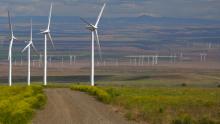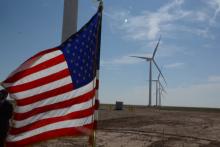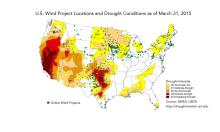CalWEA articles from the "News" category.
CalWEA articles from the "News" category.

A new plan released by the federal Bureau of Land Management (BLM) puts approximately three million acres that had been available for solar and wind development off-limits. This will make it difficult, if not impossible, to achieve the plan’s stated planning goal of 20,000 MW of renewable energy and presents a challenge to the greenhouse-gas-reduction goals laid out by President Obama and Governor Jerry Brown.
The opinion piece, by CalWEA Executive Director Nancy Rader and Michael Gerrard of the Sabin Center for Climate Change Law at Columbia Law School, highlights the fact that wind energy projects are being banned or severely restricted in several California counties and, more significantly, across vast federal lands in the state. These restrictions threaten the ability to achieve California’s climate change goals.

CalWEA Executive Director Nancy Rader and Michael Gerrard, professor and director of the Sabin Center for Climate Change Law at Columbia Law School, argue that the Los Angeles County Board of Supervisors should reverse course on its recent move to ban utility-scale wind turbines in unincorporated areas of the county, because such a ban is incompatible with averting the worst impacts of climate change.
In response to reports that Los Angeles County Supervisor Michael D. Antonovich may propose a ban on wind turbines in the unincorporated portions of the Antelope Valley under Los Angeles County's jurisdiction during a Los Angeles County Board of Supervisors meeting, CalWEA stated that the area in question contains some of the best wind resources in all of California which could lead to substantial economic benefits for Los Angeles County and help achieve the state’s greenhouse-gas reduction goals.

A new report from the American Wind Energy Association finds that wind energy saved 2.5 billion gallons of water in California in 2014 by displacing water consumption at the state’s thirsty fossil-fired power plants, playing a valuable role in alleviating the state’s record drought. Wind energy’s annual water savings work out to around 65 gallons per person in the state (200 gallons per household), or the equivalent of 20 billion bottles of water.
CalWEA submitted extensive comments on the Draft Desert Renewable Energy Conservation Plan (DRECP), a joint initiative of California and the federal government to plan for renewable energy and conservation across 22.5 million acres of desert land in Southern California. CalWEA’s comments argue that the Draft Plan fails to plan for the amount of wind energy that will be needed for California to achieve its ambitious goals to address the peril of climate change.

"If you've spent your life fighting for birds, it's hard to say "some birds may die in this windmill" (and it's perfectly smart to work with turbine manufacturers and wind developers to minimize that possibility, as many people have). But what we need to say is: every bird, and everything else that we know, is fundamentally at risk in the next few decades. In the name of birds, I want that windmill on my ridge. In the name of wild beauty, I want that windmill out my window."